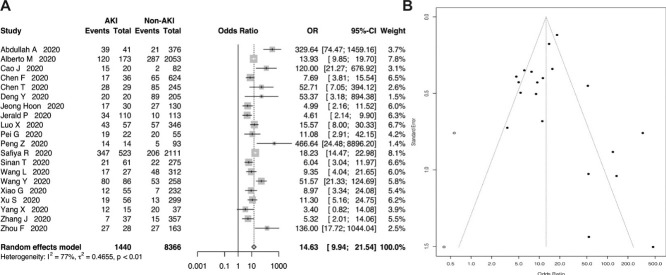- Record: found
- Abstract: found
- Article: not found
Acute kidney injury is associated with severe infection and fatality in patients with COVID-19: a systematic review and meta-analysis of 40 studies and 25,278 patients

Read this article at
Graphical abstract
Abstract
Currently, coronavirus disease 2019 (COVID-19) is spreading rapidly around the world. This study aimed to investigate whether the presence of acute kidney injury (AKI) might increase the risk of severe infection and fatality in COVID-19 patients. We searched the PubMed, Web of Science, ScienceDirect, MedRxiv and COVID-19 academic research communication platforms for studies reporting severe infection rates and case-fatality rates in COVID-19 patients with and without AKI up to June 20, 2020. The main outcomes were the comparisons of the severe infection rates and fatality rates in COVID-19 patients with and without AKI and the estimation of the odds ratio ( OR) and its 95% confidence interval (CI) for severe infection and mortality. Statistical analyses were performed with R statistical software. A total of 40 studies involving 25,278 patients with COVID-19 were included in our meta-analysis. The incidence of AKI was 10% (95% CI 8%–13%) in COVID-19 patients. The patients had higher severe infection and fatality rates (55.6% vs. 17.7% and 63.1% vs. 12.9%, respectively, all P < 0.01) with COVID-19. AKI was a predictor of fatality ( OR = 14.63, 95% CI: 9.94 – 21.51, P < 0.00001) and severe infection ( OR = 8.11, 95% CI: 5.01-13.13, P < 0.00001) in patients with COVID-19. Higher levels of serum creatinine (Scr) and blood urea nitrogen (BUN) were associated with a significant increase in fatality [Scr: mean difference (MD): 20.19 μmol/L, 95% CI: 14.96–25.42, P < 0.001; BUN: MD: 4.07 mmol/L, 95% CI: 3.33–4.81, P < 0.001] and severe infection (Scr: MD: 7.78 μmol/L, 95% CI: 4.43–11.14, P < 0.00001, BUN: MD: 2.12 mmol/L, 95% CI: 1.74–2.50, P < 0.00001) in COVID-19 patients.
In conclusion, AKI is associated with severe infection and higher fatality rates in patients with COVID-19. Clinicians should pay more attention to the monitoring and treatment of COVID-19 patients with AKI.
Related collections
Most cited references65
- Record: found
- Abstract: found
- Article: not found
Clinical features of patients infected with 2019 novel coronavirus in Wuhan, China
- Record: found
- Abstract: found
- Article: not found
Clinical Characteristics of Coronavirus Disease 2019 in China
- Record: found
- Abstract: found
- Article: not found

